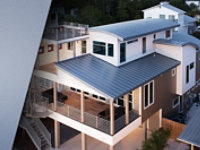
How to Select the Right Metal Coatings
Metal coatings are engineered to deliver durability and protection against the elements for exterior metal building components. Learn more about how to select the right metal coatings for your application.
Three questions to answer when choosing the right metal coatings for your next coil project
Metal coatings are engineered for performance and aesthetic capabilities to maintain the integrity of metal – one of the most important materials in architecture. Left uncoated, metal is susceptible to the elements and can eventually degrade. Metal coatings prevent degradation by providing a durable barrier that extends the overall lifespan of the metal substrate.
Choosing the right metal coatings for a metal building product or project largely depends on the environment in which the product and structure will live, but before the application stage, architects, product manufacturers and OEM-specifiers should ask themselves the following questions.
1. What is the coating application – coil or extrusion?
Selecting the right metal coating system for your project depends on the type of metal substrate and its end-use. For example, are you fabricating metal roofing made of Galvalume® or aluminum windows?
The end-use denotes the type of coating application – coil or extrusion. The biggest difference between coil and extrusion coatings is how and when they are applied. Coil coatings are applied to coiled sheets of metal before they are formed, while extrusion coatings are spray applied after the aluminum extrusion has been formed.
The product application is highly important when choosing the right metal coating, as each coating is formulated to fit each unique use.
Both methods are applied in-factory by approved applicators.
Coil Coatings: applied to flat sheets of metal in a continuous process - pre-painted
Extrusion Coatings: Aluminum profile is extruded and coatings are applied after fabrication
2. What performance properties must the metal coatings achieve?
If you’re trying to achieve extreme weatherability, flexibility/formability or damage resistance, the type of resin you choose will be critical. Think of resins as the ingredient that binds coating formulas together. Resins determine a metal coating’s overall performance, and there are multiple options for coil and extrusion applications.
Although polyvinylidene difluoride (PVDF) resins are used globally for monumental architectural projects, there are many different types including fluoroethylene vinyl ether (FEVE), silicone-modified polyester (SMP) and vinyl-coated polyester (PVC) and polyester – all of which can affect your choice for your specific application or project.
PVDF Coatings
Polyvinylidene fluoride
High-performance coatings that add vivid color and proven durability to metal architecture.
Brand: Fluropon
FEVE Coatings
Fluoroethylene vinyl ether
An exceptional coating that adds depth of color and high gloss, with special effects.
Brand: Illumipon
SMP Coatings
Silicone-modified polyester
A durable coating that provides a harder finish for applications in tough conditions.
Brand: WeatherXL
Polyester Coatings
Polyester
Customization meets innovation with this all-purpose coating for building components
Brand: PolyPREMIER
3. Which approvals or certifications must the metal coating meet?
With multiple organizations and programs surrounding building products, like the American Architectural Manufacturers Association (AAMA), American Society for Testing and Materials (ASTM International), Association of Home Appliance Manufacturers (AHAM) and the U.S. Green Building Council (LEED), it can be difficult to keep up with all of the regulations and compliances. Identify the certifications and ensure the metal coatings you choose to meet the project specifications.
The three questions above cover the basics, but there are many additional factors to consider when choosing metal coatings for your coil project.
To learn more about selecting the right metal coatings for your next coil project, contact us.

